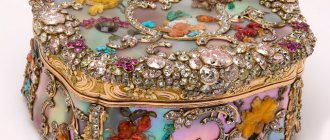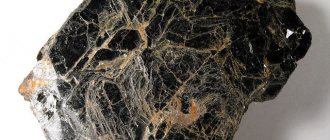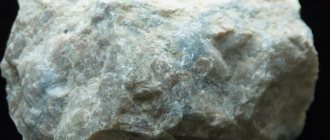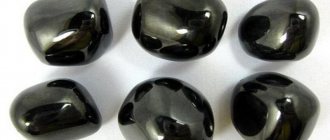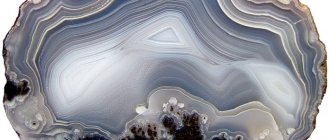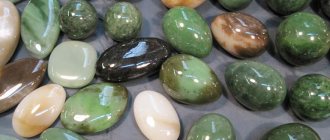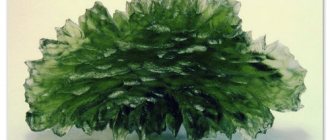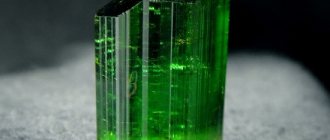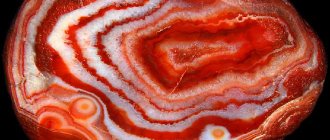Description
The mineral is formed during the cooling of lava near geothermal springs. The crystals are flat and elongated, reminiscent of lentils. Hatching patterns are visible on the edges. Most natural specimens are colorless. Yellowish, pink, greenish, brown - rare.
It is characterized by color instability. A classic example is a richly colored Madeira specimen exhibited at the World Exhibition in Paris (1867). After eight weeks in the display case, the pebble became discolored.
If the color of phenacite was stable, then its value and cost would be comparable to elite alexandrite.
It turned out that the sun was to blame. In addition, ultraviolet light causes the stone to fluoresce in different shades. Electromagnetic radiation produces a turquoise glow, gamma rays produce a yellowish glow.
Main characteristics
Phenakite as a separate independent mineral was not mentioned in mineralogical treatises of past centuries due to the fact that the crystal was often confused with quartz. Only in the 19th century, Russian stone cutter Yakov Kokovin, who discovered a gem with a warm yellowish tint, became interested in the unexpected find and decided to study it. It turned out that this was a new, previously unknown stone, which at that time was called cocowinite - in honor of the discoverer. After the discovery of phenacite, the mineral continued to be studied in the capital, where it acquired its modern name.
The stone is formed during the solidification of lava in geothermal springs, near fluorites, mica and sulfides. As a result of metamorphic processes, flat and oblong crystals are formed that look like lentils. Most of the samples obtained are transparent, but in rare cases yellow, pink or greenish specimens are found.
A distinctive feature of phenacite is its inability to maintain color intensity. For example, a gem of a rich wine-yellow hue exhibited in Paris lost its color after 2 months in the display case, becoming colorless.
After conducting research, scientists found that sunlight is to blame for the discoloration.
In addition, it was confirmed that in ultraviolet rays the stone fluoresces in different shades. Electromagnetic rays give the gem a turquoise glow, and gamma rays give the gem a lemon-amber glow.
If the mineral has become discolored, then to return the original shade the crystal must be returned to a dark place, where after a while it will restore the color, although not so rich. To make the stone sparkle with rich colors again, X-ray radiation is used.
Physical characteristics:
- hardness - 6–7;
- density - 3 g/cm³;
- strength - brittle;
- cleavage - imperfect;
- transparency - complete;
- fracture - conchoidal;
- shine - glassy, sometimes greasy;
- syngony - trigonal.
Phenakite is a fairly rare stone, so jewelry with it is not easy to find, and they will have a corresponding price. As an alternative, jewelry stores offer products with synthesized crystals.
Physico-chemical characteristics
Phenakite is a beryllium silicate.
The color is created by impurities of magnesium, boron, iron, and muscovite. But their share is tiny.
| Formula | Be2SiO4 |
| Color | Colorless, wine yellow, pink, brown |
| Stroke color | White |
| Shine | Glass |
| Transparency | Transparent |
| Hardness | 7,5 — 8,0 |
| Cleavage | Imperfect |
| Kink | Conchoidal |
| Density | 2.96 - 3.0 g/cm³ |
| singonia | Trigonal |
Phenakite is a mineral that changes color under external influence.
Story
Phenakite is not mentioned in mineralogical or chemical treatises of past centuries: due to its external similarity, it was mistaken for quartz. Only at the dawn of the 19th century, the Russian ore explorer Yakov Kokovin (from the serfs of Count Stroganov), having discovered a yellowish pebble, began to examine it. It turned out that this is a new mineral. It was named after the discoverer, and the Urals became the place where the world's first Cocowinites were found.
Further, the properties of the stone were comprehensively studied in the capital of the Russian Empire. St. Petersburg chemist N. G. Nordenskiöld proposed a term for the mineral that is more understandable to the rest of the world - phenacite. This name with Greek roots has become international.
Description of the mineral
Phenakite is a stone that is beryllium silicate. It is distinguished by absolute transparency, the ability to refract light, and pleochroism. The mineral changes color depending on the lighting.
Transparent phenakites are often found. Other varieties of this stone are less common:
- yellow;
- pink;
- Dark red;
- champagne color.
The main feature of the mineral is that when exposed to ultraviolet radiation (sun rays), it quickly loses color and becomes transparent. This happened with a rich champagne-colored gem exhibited at an exhibition in Paris in 1867. It became colorless in 8 weeks.
The color of the crystals is given by tiny amounts of iron, boron, magnesium, and muscovite. The higher the concentration of substances, the richer the color.
The name "phenakite" is translated from Greek as "deceiver". This is due to the fact that for a long time the stone was considered quartz. Only at the beginning of the 19th century Yakov Kokovin began to study the gem and came to the conclusion that it was an independent breed.
Later, a chemist from St. Petersburg, Nordenskiöld, gave the stone its modern name and recognized it as a relative of the precious alexandrite.
Phenacite deposits are found near alexandrite veins. The rock is formed from molten magma under the influence of hydrothermal waters. There are quite a lot of deposits, but over the entire period only a few hundred kilograms of rare stone have been extracted from them.
Watch the video with the stone:
Phenakite deposits have been discovered:
- in Russia;
- Ukraine;
- USA;
- Tanzania;
- Brazil;
- Zimbabwe;
- Norway;
- Nigeria;
- India;
- in Madagascar.
Despite its rarity and beauty, phenacite is not a precious mineral.
Among all the mined nuggets, 2 unique ones are the most famous:
- unprocessed mineral weighing 7 kg in the Ural Museum;
- a cut specimen weighing 570 carats is located in the USA at the Smithsonian University.
To view an overview of the history of the stone:
Place of Birth
In nature, phenacite is almost always found next to elite alexandrite. The similarity of chemical composition makes them “relatives”. Mica and fluorite are also included here.
Deposits are formed in hydrothermal formations or granite pegmatites.
Mineral phenacite
In addition to the Urals, deposits have been found in Africa, Europe (Alps, Scandinavian Peninsula, Ukraine), Asia (Sri Lanka, India).
But the total amount of raw materials is small.
Large Brazilian phenacite
Origin and location
The mineral is relatively rare. It is formed in pegmatite veins during the late stages of pneumatolithic-hydrothermal activity. Known in contact type deposits (desilified mica-fluorite greisens, pyroxene-albite-microcline metasomatites and metasomatites on granites, in hydrothermal fluorite, feldspar-fluorite, albite-bavenite and quartz veins, as well as in Alpine-type veins. Occurs in normal granite pegmatites usually in cavities in the form of crystals of two types: a) early - lenticular, rhombohedral or thick prismatic crystals with barely developed prism faces, b) late - prismatic crystals, shortened or highly elongated; observed in leaching voids of other minerals.
Uniques
The property of museums and private collections are specimens of outstanding dimensions:
- The Ural Museum of Geology owns seven kilograms of phenacite.
- The Smithsonian Institution in the USA is proud of this colorless crystal from Sri Lanka. This is the world's largest faceted crystal. Moreover, such a mass - almost 570 carats - is only a third of the original one in 294 g.
- Royal phenacites with dolomite fragments are supplied by the African state of Namibia.
At the everyday level, the most valuable and in demand are samples of the pink range.
Application
Pure transparent phenacite crystals are used in the jewelry industry. This hard mineral lends itself well to cutting and looks rich in jewelry. Visually, phenakite is similar to quartz, but when you bring phenakite to a light source, you can see a richer play of light.
Due to its transparency and ability to refract light, it is often used in replica diamond jewelry. Most often it is subjected to a stepwise emerald or diamond cut.
In the jewelry industry, products with pink stones are especially valued. Therefore, to give the mineral an attractive shade, jewelers expose colorless specimens to gamma radiation.
Large phenacite most often has various defects. Therefore, the most common size of flawless stones is 5 carats. However, exceptions do occur. A unique cut stone of 569 carats is kept in the world famous Smithsonian Institution, which is located in Washington. It was obtained from a 1,470-carat sample found in a deposit in Sri Lanka. And in Russia, in the Ural Geological Museum, a specimen weighing 7 kg is presented. It was found in the Emerald Mines, in the vastness of the Urals.
Jewelry with phenacite has an attractive appearance and is quite expensive. Visually, this mineral is similar to diamond, rock crystal, and noble beryl. This is why unscrupulous manufacturers replace expensive phenacite stones with cheaper beryl. So if you don’t want to waste money on a fake or imitation, buy jewelry from trusted places or from reputable jewelers. They will tell you how to distinguish phenacite from beryl.
Price
Although not formally considered elite, phenacite is a rare stone. Over the entire period, only a few hundredweight of raw materials were extracted.
Therefore, the price is appropriate (thousand rubles):
- cut stone (7.3 carats, 12x12x8.5 mm) – 39.6;
- cabochon (14x9x6 mm) – 10.3;
- nugget 11x8x8 mm – 0.78;
- pendant (nickel silver) – 1.7;
- pendant (silver) – 2.4;
- ring (nickel silver) – 2.7.
Ring with phenacite
Buying a nugget or a cut stone is good luck. There are few offers, the goods are not stored.
Areas of application
Phenakite is used by jewelers, stone-cutters, and is purchased by collectors of mineralogical collections:
- Jewelers love this stone: thanks to the high refractive index of light, the transparent crystal sparkles like a diamond. However, jewelry made from phenacite is created only in very few cases; such inserts do not always appear in the catalogs of domestic brands.
Unscrupulous people substitute phenacite for small diamonds or diamond placers. The diamond cut adds similarity.
- Single craftsmen offer pendants or rings with stones up to 3–4 carats. More often it is yellow-brown (that is, ennobled) or transparent.
- The stone has found wider use as a collection material.
- Balls and pyramids carved from phenacite are popular: they are sold out for esoteric practices.
A technology for producing artificial phenacite has been developed.
Practical use
Jewelers enjoy using stone to create luxurious jewelry. Finished products with the mineral barely reach 5 carats. Masters of their craft often use yellow-brown samples. Specialists cut with step, brilliant or emerald cuts.
We also mastered the technology of creating synthetic stone. But it is more often used for the underground production of fake diamonds. This is possible due to the high refractive index of light.
To get a recharge from a gem, it is enough to purchase jewelry with a very small stone, the properties of which will be clearly expressed.
Therapeutic effect
Despite its rarity, phenacite is actively used by healers and lithotherapists. And this is facilitated by the high vibrations of the mineral, which are not observed in most natural formations.
- It is a powerful stimulant of energy centers, in particular the crown chakra. It has a beneficial effect on all areas, thereby helping the body recover and diseases to leave the body.
- It is also recommended to be worn by those who have non-healing wounds on their body. There is nothing magical about this; the process of skin restoration occurs at the quantum level.
- The ability of the mineral to have a positive effect on the nervous system has been revealed.
- Regular contact with it will help enhance brain activity, so it is advisable to wear it for those who are engaged in mental activity.
- The stone is the owner of positive energy, which it is happy to share with its owner. In particular, it bestows love and kindles passionate feelings among spouses.
- Yellow samples help improve the functioning of the thyroid gland, while pink samples fight infertility.
Magic properties
- It is worth noting that phenakite has a unique energy that is aimed at combating otherworldly manifestations, therefore it can be worn as a talisman;
- It is used by knowledgeable people as a guide to the other world. In particular, phenacite helps with spiritualistic séances;
- This is the stone of businessmen and those who strive to accumulate material wealth;
- It is also used for meditation, since its energetic vibrations promote spiritual growth;
- If you want to have a prophetic dream, you can put phenacite under your pillow. Thus, you will be able to see in a dream the answer to the question posed, the solution to the problem. It helps to establish a connection with angels and higher powers on a spiritual level;
- It is worth remembering that minerals mined in different parts of the planet can affect people differently;
- Stones enhance the effects of other stones;
- A pendant with phenacite is suitable for those who strive to become higher on a spiritual level, to experience the unknown, and to plunge into the world of magic. A ball made from it also has a strong effect.
Therapeutic effect
Yoga practitioners have found that phenacite activates the crown chakra. And through it it has a beneficial effect on all energy centers of the human body.
Phenacite has a beneficial effect on all parts of the body, neutralizing diseases and helping the body recover.
The following medicinal properties of the stone have been revealed:
- It is recommended to wear it for injuries, long-term non-healing wounds, and skin diseases.
- The stone calms the nerves.
- Constant human contact with stone helps the brain work more efficiently.
- Short beads or a yellow pendant improve the functioning of the thyroid gland.
- Passions are revived even among “experienced” couples.
- Pink gems help men and women who want but are unable to have children.
The stone generously shares strong positive energy with a person.
Therapeutic effect
Yoga proponents estimate that this phenacite activates the crown chakra.
But thanks to this, it has a good effect on the active centers of the human body.
The following healing properties of the stone have been revealed:
- Recommended for use for injuries, long-term wounds, and skin diseases.
- Eases nerves.
- The endless connection between a person and a stone supports the brain to act more productively.
- Short beads or a yellow pendant cleanse the thyroid gland.
- Hobbies are rekindled even for experienced couples.
- Pink stones can also help men and women who desire but cannot have children.
He abundantly shares powerful positive energy with people.
Magic properties
The magical community claims that the superpowers of the stone are created by its energy. Science has confirmed: the mineral emits high-frequency vibrations. That is, the “magic” happens on the physical, quantum level.
The high-frequency vibrations of phenacite are universal, but are in demand primarily on the magical front:
- The stone is suitable for spiritualistic “communication sessions”. You can contact light and dark forces.
- Serves as an amulet against attacks from otherworldly entities or human negativity.
A pendant, ball or pyramid made of phenacite will be useful for beginners who want to learn the secrets of magic.
- Vibrations favor spiritual progress, which is why stones are used in meditation and similar practices.
- To have a prophetic dream, place a phenacite nugget under the pillow and clearly formulate the question. The answer will come in a dream.
- Stones in jewelry enhance the influence of other gems.
The magical properties of phenacite are also useful for earthly purposes. This is a money magnet and a talisman for those who want to get rich quickly.
The location of extraction and the color of the mineral matter:
- Yellow specimens are taken for meditation or worn to overcome the fear of change.
- Transparent or milky-white stones are the choice of those wishing to become a magician, spiritualist or clairvoyant.
- Stones from Myanmar (Burma) are designed to open the “third eye”. At the everyday level, they help get help in case of a problem.
Burmese samples are the most powerful magically.
Medicinal properties of phenacite
There is an opinion that this mineral has a beneficial effect on the entire body.
Experts suggest that white or colorless specimens relieve nervous tension, relax after a busy day at work, mitigate the effects of stressful situations, and generally improve the state of the body and mood. Pink stones have a sedative effect. The healing properties of phenacite are also manifested in the fact that it feeds a person with energy, which it takes from everything around it. Yellow stones cleanse the body of toxins, help with chronic insomnia, relieve unreasonable fears, stimulate gastric secretion, increase appetite and relieve indigestion.
Stone experts believe that phenacite enhances the healing effects of other stones, so it is recommended to use it in conjunction with other minerals.
Phenakite and Zodiac
Phenakite is the stone of Gemini, Libra and Aquarius. They will become healthier, more optimistic, richer, more successful.
The only zodiac sign that is contraindicated from contact with the stone is Virgo. A piece of jewelry or a nugget in a pocket or on a table will make them gloomy and unsociable.
Compatibility table of fecanite with zodiac signs (“+++” – fits perfectly, “+” – can be worn, “-” – is strictly contraindicated).
| Zodiac sign | Compatibility |
| Aries | + |
| Taurus | + |
| Twins | +++ |
| Cancer | + |
| a lion | + |
| Virgo | — |
| Scales | +++ |
| Scorpion | + |
| Sagittarius | + |
| Capricorn | + |
| Aquarius | +++ |
| Fish | + |
For others, the stone is suitable according to the horoscope as a safe decoration.
Features of use
Phenakite is durable, its use has only one feature.
Phenakite crystal from the Urals
Jewelry with stones should not be worn on long summer walks or on the beach: even rich natural inserts will become discolored. Jewelry should be stored in a light-proof and tightly closed box.
If the mineral has become discolored, the shade can be partially restored by placing the jewelry in a dark place for a long time.
Only hard x-rays can do this completely and quickly. If you want to get a pink pebble, the irradiation procedure is extended.
How to care for stone
Ring with phenakite
Phenakite is a durable mineral, its hardness is similar to corundum. This makes it resistant to mechanical stress, but you should not test this rare gem by squeezing or strong impacts.
Phenacite has one feature - it is very unstable to ultraviolet radiation. If this mineral is exposed to sunlight even for a short time, it will completely discolor. You can partially restore the color of the stone if you leave it in a dark place for some time. Only a specialist can completely restore the color of phenacite by applying a certain dose of X-ray radiation.
Phenakite should be stored in a tightly closed box away from sunlight. It is not recommended to store the gem with other, softer minerals, so that it does not scratch or damage them.
Phenakite is not afraid of high temperatures and acids, but it is better not to use aggressive chemicals to clean it. It is enough to wash the stone with cool water with the addition of a mild soap solution, rinse and gently dry with a soft cloth.
